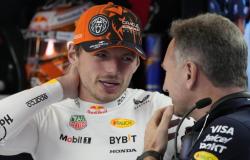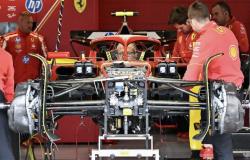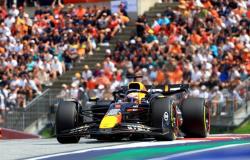Leaving aside the Canadian blackout, the Spanish GP has become a negative crossroads for Ferrari. Since then, the SF-24 has become on average fourth in the pecking order of the forces in the field counting both qualifying and the race, due to a development that has given a lower contribution than expected. At the Red Bull Ring, a track that by its characteristics should have brought the strengths of the teams closer together, both SF-24s were once again put in crisis by the setup, and the weekend with the sprint-race It came at the worst possible time for the Italian team, which is why Silverstone already represents an important test to find the right balance that has been lost for a couple of races.
With the Barcelona updates Ferrari has reduced the setup window. The bouncing is less resolvable than expected.
With the introduction of the second major package in Barcelona, after the first one that had debuted in Imola, the SF-24 lost the balance and good driveability that had distinguished it up to that point. As we reported in the post-Spanish GP, and underlined before by Carlos Sainz and then also from Leclerc and Vasseur, the updates brought to Montemelò they actually gave more load (at low speeds especially), however, the car ended up outside the operating window of the aero-mechanical platformtriggering an unexpected bounce in the fast corners. The two Maranello drivers, in addition to not being able to extract the peak performance of the new tire on the flying lap since the beginning of the season, now find themselves with a car with a deleterious bounce in the fast corners, and in Austria the last sector was a sort of nightmare for both drivers. The combination of high-speed corners and bounces amplified the deficit in those sections of the track. The problems were only partially resolved on Saturday, working mainly on the setup, with the two drivers taking rather different paths; the gap from McLaren was a good 3 tenths, a sign that in Maranello there was also a problem with the starting setup, an aspect to which Ferrari is not foreign this year, already occurred in other events (see Canada) and which after the changes in Barcelona was amplified.
“Our performance in the fast corners is exaggeratedly slow compared to our opponents” had underlined an ever analytical Carlos Sainz. The harmful bouncing forces the technicians to have a smaller setup window and to make compromises, including raising the car off the ground, as in Spain. The aerodynamic bounce remains a side effect that is difficult to eliminate completely with this generation of cars but the work done in the last two years by the teams, and in part with the changes made to the regulation of the floor heights by the FIA, had moved away the trigger point of the dolphin effect. From this point of view the teams are all in a “safety zone” and porpoising, although still present in a not very significant way for everyone, is no longer an unmanageable problem. The famous aerodynamic platform, which we often hear the technicians in the field talking about, makes us understand how to make these cars with Venturi ducts work, it is necessary a perfect combination of vehicle dynamics and downforce, to get the most out of the package you have available. In this juncture Ferrari is lacking precisely in this aspect.
There are no specific updates at Silverstone, optimization comes from the mechanical setup.
If we were to talk about medium/high speed curves, Silverstone It is one of the tracks that has in its layout a preponderance of sections in support over 180-200 km/h. At Silverstone, Ferrari will continue to work with the current package introduced in Barcelona to seek a better understanding on the track of the evolved SF-24, which is not giving what the engineers in Maranello expected. In this regard, no major updates are expected in Englandwhere instead we can expect important news from the teams that did not introduce their package in Barcelona, such as Haas. Silverstone will be important for Ferrari especially for data collection, weather permitting, in a weekend where they will return to the standard format and on a “smoother” track than Barcelona and the Red Bull Ring.
In fact, on the English circuit the changes in gradient are almost non-existent if we compare it to Austria and from the point of view of the bumps it is rather flat. The bouncing that Ferrari is suffering from essentially requires a better understanding of the new package and mainly an optimization of the setup, especially on the mechanical front, as also underlined by the Team Principal of the Italian team. A fundamental factor currently missing and which has sent the Prancing Horse technicians into crisis both in Spain and Austria. Furthermore, bringing an additional fund to English soil would not have been possible for purely logistical and timing reasons. “With the setup in Austria we made a positive step forward after the sprint. Silverstone comes at the right time because having two free practice sessions to optimize the car will definitely help us.” To conclude, land a few bumps will help mitigate the onset of hopping at Silverstonewhich in Maranello they believe is mainly due to the bumping of the road surface, rather than having a purely aerodynamic origin. From the resolution of the problem in a not very long time, there is a good part of the development road that the engineers in Maranello will continue to travel. For this reason, Silverstone will be a fundamental test bench.





